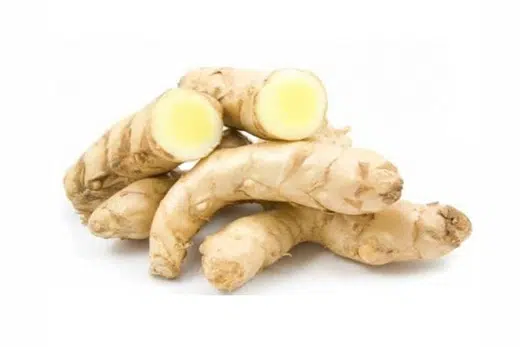Amba Haldi / Mango ginger/ Curcuma amada – Classification, Ayurvedic Properties & Dosage
Description
Mango ginger (Curcuma amada) is a rhizomatous herb known as Amba Haldi in Ayurveda. In ayurveda and Unani systems it is used as Appetiser, Alexteric, diuretic, Antipyretic, Emollient, Expectorant, and laxative. Also, in Modern science, various activities are observed such as AntiOxidant, Anti bacterial, Antifungal, Platelet aggregation inhibitory, Cytotoxicity, Anti allergic, hypertriglyceridemic, Brine shrimp lethal activity, CNS depressant activity, and enterokinase inhibitory activity.

Synonyms
- Ama harida
- Aamaragandha
- Kapoorharida
- Sugandha
- Vanyaharida
- Daru
Other Vernacular Names
- In Hindi – Amahaldi
- In English – Mango ginger
- In Gujarat – Safed Halder
- In Kannada – Ambara Sina, Huliarasina
- In Bengali – Aam ada
- In Malayalam – Amba inji
- In Indonesia – Kunyit, Kunir
- In France – Mangga
- In Germany – Mango ingwer
Taxonomical Classification
- Kingdom – Plantae
- Division – Spermatophyta
- Class – Monocotyledonae
- Series – Epigynae
- Order – Scitanimales
- Family – Zingiberaceae
- Genus – Curcuma amada Roxb
- Species – Curcuma
Habitat
Mango ginger is grown in various climatic conditions but hot climatic conditions are most favourable for maximum yield. Indian soils exhibit large varieties of mango ginger due to different climatic conditions, vegetation, topography etc. resulting in enriched heterogeneity of mango ginger. Mango ginger does well in moist but well drained soil. It can be cultivated in full sun and partial shade because of its adaptability. In India, Gujarat, karnataka, Tamil naidu, West Bengal and the hills of the western coasts of India. It is also cultivated in China, Australia, Pakistan, Indonesia and South Pacific.
Morphology
Curcuma amada is a unique spice having morphological resemblance with ginger but characteristic odour of raw mango. It is a perennial, rhizomatous, aromatic herb. The herb has leafy tuft and is 60- 90 cm in height. Leaves are long, petiolate, oblong-lanceolate, glabrous and green on both sides. At the rhizome node scaly leaves are arranged circularly giving appearance like growth rings. The rhizome is light yellow from the inside and white white towards the periphery. Flowers are white or pale yellow arranged in spikes in the centre of the tuft of leaves.
Classical Classification
- Bhavaprakasha nighantu – Hareetakyadi varga
- Kaiyadeva nighantu – Aushadhi varga
Ancient Verse
Shloka – 1
दार्वी मेदाऽऽम्रगन्धा च सुरभी दारुदारु च |
कर्पूरा पद्मपत्रा स्यात्सुरीमत्सुरतारका ||
आम्रगंधिर्हरिद्रा या सा शीता वातला मता |
पित्तहृन्मधुरा तिक्ता सर्वकण्डूविनाशिनी ||
Reference – Bhavaprakasha nighantu/Haritakyadi varga/Shloka 198-199
Interpretation of Shloka – In this shloka Amagandha is also known as Darubheveda, Surbhidaru, Daru, Karpoora, Padyapatra, Surimat, and Soorataaraka. Amahaldi smells like raw mango. It is cool(sheetla), aggeravates vaata (vaatakaarak), reduces pitta (pittashamak), sweet (madhura) and bitter(tikta)and destroys (vinashini)all itching(Sarva Kandu).
Shloka – 2
आम्रगन्धा हरिद्रा तु शीतला वातला तथा |
पित्तहृत् स्वादु तिक्ता च वृष्या स्यात्सन्निपातजित्
Reference – Kaiyadeva nighnatu/ Aushadhi varga/ Shloka 2228
Interpretation of Shloka – This Shloka describes various qualities of the herb like sheetla (cooling effect), and vatala (aggravates vata) in the body. It also pacifies pitta and cures all types of itching and skin diseases
Ayurvedic Properties
- Guna (qualities) – Ruksha (Dry in nature), Laghu (Light for Digestion)
- Rasa (taste) – Tikta(Bitter), Katu
- Veeraya (Potency) – Sheeta (cold)
- Vipaka – Katu (Pungent)
- Karma (actions) – Decreases Pitta and increases Vata dosha
Practical Uses / Benefits
Ama haldi is a well known herb in Ayurveda with numerous practical applications. These are discussed as below:
- Applying mango ginger paste on the skin, makes the skin soft and reduces itching and dryness.
- The juice of the mango ginger rhizome is given in the dose of 10ml to treat intestinal worms.
- Mango-ginger rhizome paste is applied to the joint with local sprain and swelling.
- Taking 1-2 gm powder of mango ginger with buttermilk or water improves appetiser and taste.
- It is also used in the treatment of haemostatic due to its Anticoagulant properties due to its platelet aggregation inhibitory activity.
- It can be used to prevent allergic reactions caused by nonspecific and specific mast cells.
- Fresh juice is used to cure cough, cold and throat diseases.
- The rhizome of mango ginger in various culinary purposes like, pickle, soup and a flavouring agent.
Part Used
All plant parts are used
Chemical Composition
Mango ginger possesses various phytochemicals which are listed below:
| Phytonutrients | Chemical Constituents | Properties |
| Nutrients | Sugars, Starch, Fibres, Proteins, Amino acids, Fatty acidsMinerals: Iron, Calcium, Phosphorus, Sodium, Copper, Nitrogen, Magnesium, Molybdenum, Potassium, Manganese, Sulphur, Sodium, Zinc.
Vitamins: Thiamin, Niacin, Pyridoxine, Riboflavin, Vitamin A, Vitamin E and Vitamin E. |
Anthelmintic, Anti-inflammatory, Entero kinase inhibitory |
| Essential Oils | 𝝱- ocimene, Borneol, 𝝰- Longipinene, Camphene hydrate, Thymol, Curzerene, Myrcene, 𝝰- Guaiene. | Repellent Activity, Antioxidant, Emollient, Antifungal |
| Curcuminoids | Curcumin, Bismethoxycurcumin, Bisdemethoxycurcumin | Anticancer, Antitubercular, CNS depressant |
| Bioactive Compounds | Diterpene dialdehyde, Labdane, Amadaldehyde, Zederone, Difurcocumenonol. | Anti microbial, Anti inflammatory, cytotoxicity, Antispermatogenic, Anti-inflammatory, Antitubercular, Platelet aggregation inhibitory activity. |
| Phenolic Compounds | Caffeic,Ferulic acid, Gentisic, P-coumaric acid, Gallic acid, Syringic acid, Cinnamic acid, Protocatechuic | Antioxidant, Antipyretic |
Dosage
-
- Internal Use
- Swaras / Juice
- Churna / Powder
- Kwath / decoction
- External Use
- Internal Use
Its juice or paste can be used for local application.
Classical Products
Asthi Sandhanak lepa
Conclusion
Akhuparni is widely used in ancient times for treating my problems such as skin infections, flu,cough, urinary infections and also used as a worm repellent mentioned in Ayurvedic scriptures. But in recent times, many other properties such as Anticonvulsant, Antipyretic, Anti cancer, Anti diabetic, Antioxidant are discovered that makes the herbs more therapeutically important in future.



